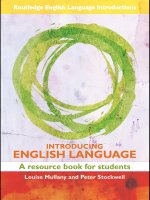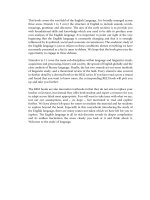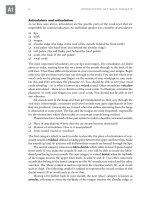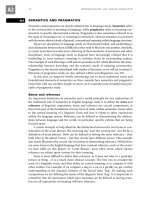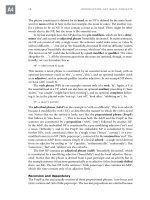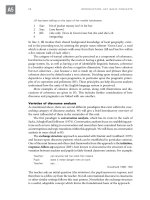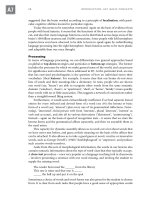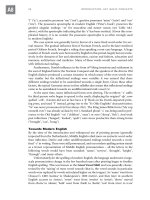Introdungcing English language part 17 pdf
Bạn đang xem bản rút gọn của tài liệu. Xem và tải ngay bản đầy đủ của tài liệu tại đây (283.67 KB, 6 trang )
82 DEVELOPMENT: ASPECTS OF ENGLISH
is taking place in this interaction. Jill and Sue talk at exactly the same time, collabor-
ating and agreeing with one another by engaging in supportive simultaneous talk to
produce their discourse jointly. They use repetition and say similar things at the same
and at slightly different times.
While supportive simultaneous talk occurs very frequently in private, informal
contexts, it can also take place in formal, public contexts. In the following ex-
ample, which also utilises the ‘musical score’ style of transcription, we have two
male business managers using supportive simultaneous talk during a business
meeting:
The meeting participants have been discussing changes to stock ordering. Rob is the
meeting chair and is drawing the discussion to a close.
1 Rob: So we just need to think about how we
2 Rob: [(-) how we can categorize ] that [how ] we look at it separately
3 David: [how we categorize on that ] [yeah]
In lines 2–3, David and Rob utter a remarkably similar utterance, almost saying exactly
the same thing at exactly the same time. This is a classic illustration of supportive
simultaneous speech and firmly indicates that they agree with one another. David
reiterates his agreement by issuing ‘yeah’ simultaneously here too, in line 3, known
as a supportive minimal response. This short utterance is not an attempt to take the
floor, but is instead a signal of active listenership and agreement.
Come up with other contexts, either formal or informal, where supportive simul-
taneous talk takes place, using the above examples as a guide.
Topic
Another area of examination which conversation analysts focus upon is that of con-
versational topic. Again, context is a crucial consideration. In informal settings where
conversation is progressing well, topic change usually occurs gradually: there is topic
drift as speakers gradually move from one topic to another. This contrasts with more
formal settings, particularly institutional or organisational settings such as courtrooms
or, to a lesser extent, business meetings. In courtroom settings the turn-taking system
is rigidly governed by the judge. In business meetings, particularly formal, pre-
planned encounters, it is common practice for a written agenda which formally lists
the topics to be covered to be circulated beforehand. It then becomes the job of the
meeting chair to ensure topic shift during the meeting according to the order of
the written agenda text. In contrast to topic drift, successful topic shift should take
place swiftly and deliberately. Agenda-based topic shifts can be achieved quickly and
concisely, as participants are all aware of what the topics will be beforehand. This is
illustrated in the meeting extract below:
Meeting chair Chris has been discussing financial budgets, a specified topic on the
meeting agenda
.
He is bringing this topic to a close
.
1 Chris: Errm I have it on memo I’ll get you the information
2 Stuart: Yeah (.)
CONVERSATION 83
3 Chris: Okay (.) recruitment
4 Jim: Yeah
((Chris talks on the topic of recruitment followed by discussion))
5 Chris: You okay with that Stuart yeah?
6 Stuart: Okay
7 Chair: Okay so if you can work towards that that will be great (-) err
8 a couple of revised store aims (.) at tills . . .
At line 3 Chris initiates topic shift from ‘financial budgets’ to ‘recruitment’, the
next specified topic listed on the meeting’s written agenda. He signals this transition
by use of ‘okay’, a discourse marker, marking a transition in the interaction, followed
by a short pause and then direct naming of the next agenda item. In line 5,
he checks Stuart is happy with what they have agreed to do regarding recruitment,
summarises what Stuart needs to do and then positively evaluates this. The topic
shift is then signalled by a lengthy pause and a hesitation (‘err’). The next topic is then
asserted by a declarative (like ‘recruitment’, this topic was listed on the written
agenda as ‘revised store aims’) followed by a short pause. The details of the topic then
begin ‘at tills’.
Although topic change in informal settings is a much less rigid process, speakers
do need to signal why they are introducing a particular topic at a particular moment
in time. Even in the most informal of contexts where speakers know each other very
well, there is still a need for new topics to be justified, otherwise speakers run the risk
of being negatively evaluated as conversational bores or as individuals who ramble on
rather aimlessly, without paying adequate attention to the need for topical relevance.
This leads us back to politeness and the importance of paying attention to face needs
(B3).
In the following example, Jill introduces a new topic firstly by carefully ensuring
that the previous topic is finished. After two evaluative comments on the previous
topic (‘oh dear’ and ‘arrrrr’) and a lengthy pause (line 3) she then establishes the new
topic’s newsworthiness, thus justifying why this particular topic shift and why now.
As with Jill and Sue’s example of supportive simultaneous talk above, this is a rather
collaborative enterprise:
Jill and Sue are talking about a man who lives by them, whom they both frequently
see in the neighbourhood.
1 Sue: I think his sister nags him so he doesn’t stop too long
2 [((laughs))]
3 Jill: [((laughs))] oh dear (.) arrrrr (-) did I tell you (.) erm my niece
4 had a baby (.) I don’t think I did did I? You know I said she
5 was having her fourth baby (.) did I tell you Sue?
6 Sue: I said to Suz- to you about Sharon having a baby
7 didn’t I=
8 Jill: =that’s right
9 Sue: having a baby daughter and you says ‘oh my niece is waiting
10 [to have her baby’]
11 Jill: [she was ] due (.) she she had the baby two two
12 weeks old this week
84 DEVELOPMENT: ASPECTS OF ENGLISH
Jill negotiates the newsworthiness of her new topic by asking Sue whether she has
told her before that her niece had given birth (lines 3–4). She back-tracks further
by asking Sue to confirm that she had told her that her niece was pregnant (line 5).
These questioning strategies help Jill ascertain the newsworthiness of the topic and
aid in confirming exactly where she needs to start the topic, ensuring that she does
not repeat any information that may have been given already. Following confirma-
tion from Sue, where Sue recounts one of their previous conversations and reports
Jill’s previous speech to her (lines 6–7 and 9–10), Jill goes ahead with her topic
(lines 11–12).
Consider the last conversation you had which took place in a similar context to
Jill and Sue’s conversation. What topics did you talk about? Did the topic drift or shift?
What does this tell you about your relationship with these speakers?
In overall summary, in this unit the tools and techniques of conversation analysis
have been investigated. Producing analyses of the various facets of the turn-taking
system and topic can result in fruitful and thorough analyses of discourse being pro-
duced in a multitude of different settings.
LITERACY
Writing is not simply speech written down. Though of course there are close con-
nections and influences between speech and writing, it is better to think of writing
and speech as two distinct but cognate systems, both of which represent the more abstract
system of language. The distinctiveness between speech and writing can be seen right
across the structure of language in each case. A simple comparison of a conversation
and a passage of written text will quickly reveal significant differences in vocabulary
choice, fluency, clause length and complexity, sequencing of the main point, and address
forms, among many other variations. To give only a few examples (see also strand 5):
q Speech is prototypically dialogic; writing is – at least initially – more monologic.
So speech tends to have more explicit second-person address forms, imperatives,
invitations, and supportive feedback phrases than writing.
q The basic unit of speech is the utterance or turn; in writing it is the clause.
So speech turns tend to consist of simple clauses, whereas writing often features
complex or compound multi-clause sentences.
q Speech tends to be spontaneous; writing tends to be planned. So writing is more
likely to feature multiple logical relative clauses such as ‘if , and , or ,
then . . .’, or ‘because of this, which , then . . .’, and so on, and speech is more
likely to have vague words like ‘stuff ’, and ‘thing’.
q Speech is tolerated in many accents; writing tends to have a strongly prestigious
and standardised form that is socially preferred and sanctioned. So variation in
pronunciation is accepted, whereas variation in spelling is not. English spelling
largely represents medieval pronunciation at the point at which printing froze many
spelling forms (‘through’, ‘knight’, ‘name’). Even in languages that have a more
B6
LITERACY 85
phonetic spelling relationship (such as Italian), there are still various accents that
can be used for a single unchangeable spelling.
q Speech tends to be face-to-face; writing tends to be displaced in time and space.
So speech tends to consist of two or more people taking turns, asking questions,
offering opinion and viewpoint explicitly. Writing tends to be free of the context,
whereas speakers can refer to ‘this’, ‘that’ and ‘those’ things that are in their im-
mediate vicinity, without further explanation.
q Speech exists in the aural medium whereas writing is visual. So speech features
more sound-effects, intonation-effects and emphatic gestures, whereas writing relies
more on shape and structure, and is only able to signal sound-effects iconically.
Becoming literate
Clearly we acquire speech before writing (see A6): speech has a 4–5 year head-start
on writing in most formal educational systems of the world. This means that pre-school
children only have one system for representing language (their speech) before they
are encouraged to learn another (writing), and so early writing is strongly affected by
the child’s speech capacities at age 5. Between this point and early teens, both speech
and writing skills continue to develop and influence each other. In this unit, we will
outline the stages of the development of literacy in these years.
The general assumption for most people would be that children’s writing develop-
ment begins with learning the alphabet and being able to write the letters – though
of course ABC (/ai bi£ si£ di£ i£™f dni£/) rather than abc (/æ be ke de™fe ge/ and so
on) are learned first. People might assume that simple phonetic words (‘cat’, ‘dog’,
‘went’) are then learned, followed by words with digraphs (‘the’, ‘ship’, ‘chop’), and
non-phonetic words with various irregular or ‘magic’ rules (‘time’, ‘brought’, ‘knife’).
Then it might be supposed that sentences are learned with spaces between words,
punctuation and capital letters, and finally sequencing of narratives and other
text-level genres are mastered.
In fact, literacy development is much more complicated than this, with several
of these processes developing alongside each other. The evolution of narrative skills,
for example, can be observed at a very early stage, even if those narratives are very
simple or apparently poorly formed from an adult perspective. It is important to
realise – as with the acquisition of speech – that literacy should not be viewed as
an imperfect version of adult writing, with errors and omissions, but as a form in its
own right which gradually comes to converge with adult writing. Children’s written
capacity is usually roughly sufficient at each stage for the level of expression that they
require. As these expressive requirements advance alongside their socialisation into
a print-rich culture, so their need for literacy development advances too.
Scribble script
Children, especially those with older siblings, will scribble circles and whirls while
colouring or drawing that they regard as writing. This initial stage of pre-school
‘writing’ is important both in mechanical training and in the conceptualisation that
marks have representative meaning. In the transition around initial schooling, children
will often imitate adults’ practices in writing – typically this will involve writing notes
or shopping lists. Children’s pre-school shopping lists will look like scribbled lines,
86 DEVELOPMENT: ASPECTS OF ENGLISH
though (Western) features such as linearity, left to right and top to bottom, and gaps
between ‘words’ can often be noticed even at this stage. Children will ‘read’ out
their shopping lists as genuine grocery items, though of course their spoken list
will change each time they ‘read’ aloud: they do not in fact have their own secretly
denotational scribble system.
Naming and captioning
One of the first recognisable words to appear is the child’s own name. Being able to
recognise your own name (to identify possessions, your coat peg, or just for the fun
of it) is a skill that adults encourage at an early stage, and children quickly learn to
shape their own name in writing. The letters of the child’s own name are often those
which are also most strongly learned and recognised in other words. It seems that the
first function of this genuine writing is labelling and captioning, with self-drawings
of the child being named in writing, and then other family and friends being labelled,
and other drawn objects similarly captioned. Sequences of captioned drawings, or a
network of labels on a page of paper are used narratively – often the story is told as
the child draws/writes it radially on the page, rather than in a linear sequence that can
be read out afterwards.
In these early stages, children’s attention is focused largely on mastering the mech-
anics of making legible letters of roughly equal size, ensuring that the directionality of
letters is right (contrasting ‘p’ / ‘q’ or ‘b’ / ‘d’ or ‘n’ / ‘h’), writing left to right along
a line and top to bottom down a page, creating spaces between words by placing
a finger after the last letter, and not writing off the margin onto the table-top. This
preparation stage develops into a consolidation stage after a couple of years at which
children are able to express their speech in writing. Later, they can differentiate speech
patterning from writing, and lastly – by age 9–10 – most children possess integrative
knowledge to be able to choose which blend of patterning is most appropriate for their
communicative purpose.
Pattern-generation
Children begin to experiment with patterns that seem to constitute their own rules
and principles as soon as they begin to learn letter shapes, syllable shapes and word
shapes. For example, many schools using a ‘phonics’ approach teach the small letter
sounds (/æ be ke/ not /ai bi£ si£/) first. Non-phonetic vocabulary is a challenge to a
pure phonics approach (‘lamb’, ‘lame’, for example), so children will try to create their
own pattern: ‘lam’ for lamb and ‘lAm’ or ‘laam’ for lame. Similar patterns will be applied
across a large range of words.
The patterns that children generalise cannot be regarded as rules, though, since
they are often highly variable. So ‘pole’ for target poorly does not always get gener-
alised to produce ‘hole’ for holy, though holly might be spelled ‘hole’. Similarly, a child
who uses a capital to signal the vowel shift produced by CVCe (consonant-vowel-
consonant-e as in ‘name’, ‘mite’, ‘fame’) as in ‘lAm’ for target lame might on other
occasions use doubling ‘shiin’ for shine or a variant digraph ‘piel’ or ‘payl’ for pile,
and so on. Word-boundaries are also flexible, so ‘wonsa pona taym’ for once upon
a time or even ‘wyanetn’ for wire netting have been observed. Clearly, these are also
influenced by pronunciation and accent patterns.
LITERACY 87
Vocabulary development in writing is obviously dependent on the size of the child’s
spoken vocabulary. For example, a child whose past tense of ‘bring’ is ‘bringed’ will
not recognise ‘brought’ as a genuine word. This is a good example of where the ex-
perience of the written form is likely to expand the spoken repertoire. In general,
though, the influence is the other way round. Early vocabulary (up to age 10) tends
to develop by the acquisition of new words and their extension by derivation (plural
-s, person agreement, tensing and aspectuals), whereas the adaptation of complex
morphology seems to be a late skill: so younger children are unlikely to write
‘unlikely’ even though they might have ‘like’ and be able to read and understand the
prefix ‘un-’ and the suffix ‘-ly’. As vocabulary extends in later years, children make
use of synonyms to avoid lexical repetition for aesthetic and cosmetic reasons.
Speech-influence to written conventions
Early examples of coherent writing are often strongly speech-like. Since the sentence
is not a unit of speech, children initially do not have a representative model for the
main unit of writing, and so their production echoes oral turns very closely. As chil-
dren develop the ability to chain clauses together in writing, after two or three years
of schooling the clauses are less likely to be connected simply by ‘and’ and more likely
to be related in more logically complex ways using ‘though’, ‘because’, ‘before’,
‘while’ and so on. Ultimately, the use of conjunctions decreases altogether as clausal
apposition, relative clauses, and implicitness in logical argument take a more sophis-
ticated role. At the same time, conversational tags (‘like’, ‘you know’), which might
have appeared in some form early on, are discarded. Conversational vocabulary
choices (‘stuff ’, ‘like that’, ‘and all’) are replaced by more formal choices.
Narrative and other generic discourse patterns emerge, so that the opening of a
text will signal (often in a headline title) what the passage is about; the text will begin
with orientation to help the reader create the participants and setting; the core of
the text itself will feature embedded evaluations and other commentary that digresses
from the main line of the story or argument; and the text will end with a reiteration
of what the point of the writing was, or some sort of conclusion. Narrative is the
most popular form of school text, with the majority of children’s writing focusing on
recounting experience, and the majority of reading scheme books being narrative
in orientation.
Freeing from bound context
Gradually as literacy develops, children’s writing moves from being bound to the con-
text to becoming context-free. In other words, it becomes possible to read children’s
texts without needing to be in the same surroundings as the child in order to under-
stand the referents. ‘This’, ‘these’, those’, and ambiguous ‘it’ or ‘he’ begin to be intro-
duced with full identifications, followed by co-reference: ‘There was a boy. He was
called Eric.’ This shift indicates a growing awareness of the diversity of audience that
writing has that speech does not easily have. Children like to write cards or letters to
family, grandparents, neighbours and friends who are not immediately in the environ-
ment. These developments involve learning about registers and genres.
For example, early children’s writing often involves an explicit signal in the
beginning that the pragmatics of the current situation are suspended (‘Once upon a
